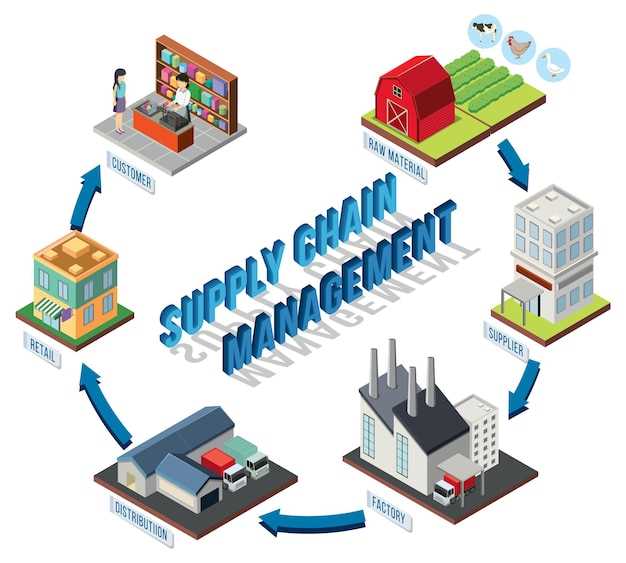Implement automated, carbon-aware procurement and logistics planning now to reduce emissions more than 20% within 12 months. This concrete step links real-time data, predictive analytics, and end-to-end visibility to directly mitigate environmental impact across supplier networks. This approach has been validated by benchmarks in multiple industries.
Automating flows of information and physical goods reduces empty miles, lowers transactions costs, and helps align demand with available capacity. Companies that adopt route optimization, warehouse automation, and supplier portals report improvements in on-time delivery and up to 25% fewer emissions from transportation.
By integrating blockchain for traceability, you find anomalies in flows, verify commitments with suppliers, and mitigate environmental emissions. This approach protects data integrity and helps avoid costly double entries and errors.
Automation connects transactions across procurement, logistics, and production, and creates a closed loop that makes commitments real and measurable. The most skilled teams can use dashboards to find risk hotspots, compare supplier demand signals with capacity, and identify ways to cut emissions without sacrificing service levels.
Utilizare predictive analytics to forecast demand, align production, and avoid overstock. This dynamically reduces wasteful energy use in manufacturing and distribution, and aligns with commitments to cut environmental footprints.
To begin, map critical flows and pilot a 90-day test in one region, then scale as gains become clear. Train the most skilled planners in data-driven decision making, and pair them with blockchain-enabled suppliers to ensure transparent transactions and reliable demand signals.
Automation-driven energy optimization in warehouses
Implement predictive, automation-driven energy optimization in warehouses by automating lighting and HVAC in high-density areas and tying controls to a centralized platform that learns from occupancy, times, and climate forecasts. This keeps energy use aligned with actual demand, lowers peak electrical load, and provides support for consumers and partners. In jusda facilities, combined lighting and cooling automation can deliver 25–35% savings in lighting energy and 15–25% reductions in cooling energy in the first year, with faster payback at scale. This progress is encouraging for consumers and partners.
To execute effectively, map complete energy use to areas such as receiving docks, high-density racks, and order-picking lanes. Install occupancy sensors, daylight harvesting, variable frequency drives on fans and conveyors, and demand-controlled ventilation. Automating maintenance with predictive maintenance alerts keeps equipment in spec and reduces energy waste caused by mismanagement. Collect data hourly, track trends, and scale proven configurations to multiple sites.
Key steps for automation-driven energy optimization
Audit current energy use in each area and identify the top three energy drivers. Select an energy optimization platform that integrates with existing BMS and WMS, then run a 90-day pilot in one zone before broad rollout. Define target metrics such as kWh per m2, kWh per pallet moved, and peak-demand reductions. Create a cross-functional team including operations, maintenance, and IT to own adoption and data governance, and use a phased rollout to manage risk while keeping operations complete and on schedule.
Leverage data to support climate goals, share insights with suppliers and customers, and encourage continuous improvement across multiple facilities. Maintain a continuous improvement loop by reviewing monthly results with site managers and adjusting controls as orders mix and times of activity shift.
Monitoring, maintenance, and risk management
Establish KPIs like energy intensity, on-peak energy share, and maintenance cycle compliance. Connect automated alerts to predictive maintenance so misalignment or device drift triggers timely service. Keep the system scalable by standardizing configurations across sites but allowing local tuning for climate, dock times, and product mix. This approach reduces risk under pressure from demand swings and supports adoption by operations teams, maintenance staff, and leadership.
Robotics for packing, loading, and palletization to reduce truck cycles
Deploy a modular robotic packing, loading, and palletization cell at the dock with a dual-robot setup, end-effectors optimized for cartons and pallets, and vision-enabled control. This implementation reduces truck cycles by 20–35% within six months by speeding packing, optimizing load plans, and ensuring stable palletization. theres no guesswork–pilot the cell and scale as results consolidate.
- Edge intelligence on the line: run image-based perception, grip adjustment, and pallet-pattern updates locally to trim cycle times and keep connectivity strong between robots and the control system.
- Equipment and line design: select two collaborative robots plus a palletizing unit, with quick-change grippers and vibration damping to handle mixed freight without damaging goods.
- Implementation steps: start with a 4–6 week pilot in a single dock lane, then expand to a full cell across shifts. Include on-site training for operators and maintenance staff to reduce strain and boost uptime.
- Performance metrics and savings: target a 15–28% drop in unit cycle times and a 10–20% reduction in freight damage. Track fill rate, stack stability, pallet height consistency, and overall equipment utilization to quantify savings per pallet.
- Integration with systems: connect to WMS and ERP for dynamic load planning, order visibility, and freight documentation. Ensure data flows across the international network, with a clear source of truth (источник) for packing rules and pallet patterns.
- Chains alignment: synchronize packing, loading, and transport chains to prevent handoff delays at the dock and maintain steady throughput.
- Training and change management: provide 8–12 hours of operator training and 4–6 hours of maintenance coaching on each shift, plus ongoing coaching over growing volumes to maintain performance gains.
- Safety and pressure control: implement overload protection, safe-stop features, and adjustable gripper pressure to protect products while keeping pace with the line.
- Image and technology: leverage high-resolution vision to validate item orientation and placement, feeding a smart planning engine that updates patterns in real time for better stability.
- Just and scalable approach: adopt a jusdas-inspired iterative rollout to validate gains quickly and scale when results stabilize, ensuring a steady path to international operations.
AI-powered route optimization to cut freight emissions
Implement an automated routing platform that ingests current traffic, weather, and road data to produce optimal itineraries for every freight move. The system stays connected to drivers, dispatch, and warehouses, delivering visibility and timely check-ins on deviations while machines learn from real-time and historical inputs to improve decisions. The engine will drive emissions down while maintaining service levels, and the plan will play a key role in aligning actions across teams.
Kick off with a 12-month roadmap anchored in commitments to reduce pollution. In the initial pilot, optimize routes for 3 regional hubs and 50 trucks, yielding 8-12% lower fuel burn and 6-15% less CO2e per route. Expand to greater networks and, eventually, scale to national fleets as models improve with current data and learned patterns, staying within budget and delivering better service.
To mitigate inefficiencies, run daily optimization cycles that respond to current conditions and constraints, including payload, driver hours, and regulatory limits. Track flows from origin to destination, minimize idle time and deadheading, and target a 12-18% improvement in idle or empty-mile flows within six months. Establish a governance layer to ensure data quality and security, ensuring benefits are realized.
Enablers for sustained value
Invest in skilled engineers and operators who maintain automated systems, tune models, and translate outputs into practical dispatch decisions. Ensure the platform remains within governance guidelines, with robust data quality checks and clear accountability. Provide drivers with simple, actionable guidance via mobile apps to support connectivity and stay informed of changes, helping to drive greater reliability and lower emissions across the network.
Digital twins and real-time dashboards for carbon monitoring
Implement digital twins for key logistics flows and set up real-time dashboards to monitor carbon emissions across the network. This approach lets you map vehicles and container movements, pinpoint mismanagement hotspots, and stay aligned with a roadmap that guides actions across the company. Based on live data, you gain precision in targeting high-emission transactions and routes, enabling rapid, data-driven decisions.
Integrate sensor streams from fleets, warehouses, and loading docks into a single model. Digital twins simulate energy and fuel use, optimize carrier choices, and enable autonomous dispatching for routine lanes. Real-time dashboards break out emissions by mode, route, and vehicle, empowering teams to intervene within minutes. The system uses shared data from sourcing and suppliers, allowing apples-to-apples comparisons and visibility across the full transportation network.
The platform keeps employee teams engaged and stay accountable, reduces misalignment between planning and operation, and helps avoid bottlenecks that cause unnecessary container idle time. This transparency is encouraging collaboration across sourcing, suppliers, and carriers. With a governance framework and clear ownership, you monitor progress over time and encourage continuous improvement. Further, as you scale, the analytics stay based on a common data model, guiding investments in the tech stack and ensuring gains compound across warehouses, distribution centers, and cross-border transportation.
Implementation targets: start with 5-10 high-emission routes, connect telematics, ERP, and WMS data, and publish weekly dashboards for the core team. Expand to 20-30 routes within six months and extend to suppliers and partners for shared accountability. The roadmap should include quarterly reviews, a clear owner, and a plan to train employees so they can act on insights and drive measurable reduction in emissions.
Implementation steps
1) Define the scope: select top flows and the vehicles and containers with the largest emissions footprint. 2) Connect data: bring telematics, ERP, and supplier transactions into a unified model. 3) Deploy dashboards: present emissions by mode, route, and leg, with alerts for anomaly spikes. 4) Govern and scale: assign an owner, create a feedback loop with sourcing and suppliers, and monitor progress against targets.
Automated circular sourcing and reverse logistics for refurbish/reorder

Start by mapping all product streams and deploy automated reverse-logistics routing in your warehouses to cut cycle times by up to 30% and reduce damage during returns. Create a collaborative network that connects suppliers, refurbish centers, and customers to streamline refurbish/reorder loops, improving connectivity across the chain. These actions help capture insight early, align with needs, and set a better baseline for growth.
Automated sorting lines, AI-driven triage, and autonomous conveyors speed the refurbish workflow. Machines classify returns by condition, route them to the right repair station, and push inventory updates to the system in real time, driven by intelligence and centralized connectivity that keeps customer orders accurate and on track. This approach reduces labor bottlenecks and creates smoother, faster ways to reach refurbished stock.
Data from pilots shows these gains: labor hours drop 28–42%, handling errors fall by about 60%, and transport distances shorten 12–22%. Insight from these results helps design better queues, smarter routing, and tighter quality gates for refurbished products, encouraging more volumes through the circular loop and promoting sustainable transport patterns.
To implement effectively, start with these steps: deploy RFID tags and IoT sensors to track products across returns, refurbish, and reorder stages; build an integrated platform that uses real-time analytics to flag refurbishable units; design autonomous routing between returns, refurbish centers, and customers for faster cycles; align with suppliers to promote closed-loop packaging; and invest in automated testing and quality assurance to maintain product reliability. These moves strengthen labor efficiency, enhance connectivity, and support a growing network of refurbished products that meet customer needs while reducing overall environmental impact.

 Sustainable Supply Chains – How Automation Reduces Carbon Footprint">
Sustainable Supply Chains – How Automation Reduces Carbon Footprint">
